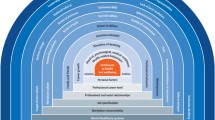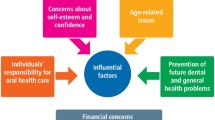Key Points
-
Reports that about a fifth of the adult population in England are dissatisfied with the quality of dental care they receive.
-
Highlights the large variation in the quality of dental care experienced by the public, and large differences between population sub-groups.
-
Suggests that dentistry is many years behind general medical practice in our understanding of quality.
Abstract
Background There is a lack of evidence and poor understanding of quality measurement and improvement in dentistry. The aim of this study was to undertake a nationally representative survey of the public in England to explore their views on the meaning of quality in dentistry.
Methods A cross sectional survey of the adult population (18 years and over) of England was undertaken. A sample size of 500 was set to provide a precision to plus or minus 5% after allowing for item non-response. A quota sampling approach was used, with predetermined quotas set for sex, age, working status and tenure to ensure the sample was nationally representative. Question selection and design were informed by the literature and a series of interviews with the public. Simple content analysis was used to identify themes in the responses to open questions. Dental service use, gender, age, ethnicity and social class were recorded. Frequency distributions were computed and outputs were cross-tabulated with various population sub-group categories.
Results Five hundred and thirteen people were interviewed. Approximately 20% of patients reported that their care was suboptimal; a third thought it was poor value for money and 20% did not trust their dentist. Good interpersonal communication, politeness and being put at ease were the most important factors that elicited positive responses. Negative factors were cost of care and waiting times. In making an assessment of quality, access (40% of all responses), technical quality of care (35%), professionalism (30%), hygiene/cleanliness (30%), staff attitude (27%), pain-free treatment (23%), value for money (22%), and staff putting patients at ease (21%) all emerged as important factors.
Conclusions Quality in dentistry is multi-dimensional in nature, and includes different elements and emphases to other areas of healthcare. The results will inform the development of a measure of quality in dentistry.
Similar content being viewed by others
Log in or create a free account to read this content
Gain free access to this article, as well as selected content from this journal and more on nature.com
or
References
House of Commons Health Committee. Dental services fifth report of session 2007–2008. London: The Stationery Office Limited, 2008. Online report available at http://www.parliament.the-stationery-office.com/pa/cm200708/cmselect/cmhealth/289/289i.pdf (accessed May 2015).
Department of Health. Equity and excellence: liberating the NHS. London: Crown Copyright, 2010. Online article available at https://www.gov.uk/government/publications/liberating-the-nhs-white-paper (accessed May 2015).
The NHS Constitution for England. London: HMSO, 2013. Online constitution available at https://www.gov.uk/government/publications/the-nhs-constitution-for-england (accessed May 2015).
Roland M . Linking physicians' pay to quality of care – a major experiment in the United Kingdom. N Engl J Med 2004; 351: 1448–1454.
Campbell S M, Kontopantelis E, Hannon K L, Barber A, Burke M, Lester H E . Framework and indicator testing protocol for developing and piloting quality indicators for the UK Quality and Outcomes Framework. BMC Fam Pract 2011; 12: 85.
O'Malley L, Tickle M, Brocklehurst P B, Walsh T, Glenny A. M, Campbell S M . Quality indicators for general dental practice: a systematic scoping review. J Public Health Dent 2015 (submitted).
Bailey E, Tickle M, Campbell S, O'Malley L . Systematic Review of Patient Safety Interventions in Dentistry BMC Oral Health 2015 (submitted).
Tickle M, Campbell S M . How do we measure quality in primary dental care? Br Dent J 2013; 215: 183–187.
Department of Health. Dental quality and outcomes framework. London: DH, 2011. Online article available at https://www.gov.uk/government/uploads/system/uploads/attachment_data/file/216300/dh_126627.pdf (accessed May 2015).
Dental Quality Alliance. Quality measurement in dentistry: a guidebook. Chicago: American Dental Association, 2012.
National Institute for Health and Welfare (THL). A Nordic project of quality indicators for oral health care. Report 32/2010 Nihtilä A. (Ed.) Helsinki, Finland 2010.
Donabedian A . Evaluating the quality of medical care. Millbank Mem Fund 1966; 44: 166–206.
Maxwell R J . Quality assessment in health. Br Med J(Clin Res Ed) 1984; 288: 1470–1472.
Groves R et al. Survey methodology. 2nd ed. Wiley, 2009.
Scarbrough E, Marsh C . Testing nine hypotheses about quota sampling. Int J Market Res 1990; 32.
Campbell S M, Tickle M . What is quality primary dental care? Br Dent J 2013; 215: 135–139.
Campbell S, Tickle M . How do we improve quality in primary dental care? Br Dent J 2013; 215: 239–243.
Morris J, Chenery V, Douglas G, Treasure E . 6. Service considerations - a report from the Adult Dental Health Survey 2009. The Health and Social Care Information Centre, 2011. Online report available at http://www.hscic.gov.uk/pubs/dentalsurveyfullreport09 (accessed May 2015).
Palmer H R, Donabedian A, Povar G J . Striving for quality in health care. An inquiry into policy and practice. Michigan: Ann Arbor, 1991.
Acknowledgements
This paper presents independent research funded by the National Institute for Health Research (NIHR) under its Programme Development Grant Programme (Reference Number RP-DG-1211-10007). The views expressed are those of the author(s) and not necessarily those of the NHS, the NIHR or the Department of Health.
Author information
Authors and Affiliations
Corresponding author
Additional information
Refereed Paper
Rights and permissions
About this article
Cite this article
Tickle, M., O' Malley, L., Brocklehurst, P. et al. A national survey of the public's views on quality in dental care. Br Dent J 219, E1 (2015). https://doi.org/10.1038/sj.bdj.2015.595
Accepted:
Published:
Issue date:
DOI: https://doi.org/10.1038/sj.bdj.2015.595



